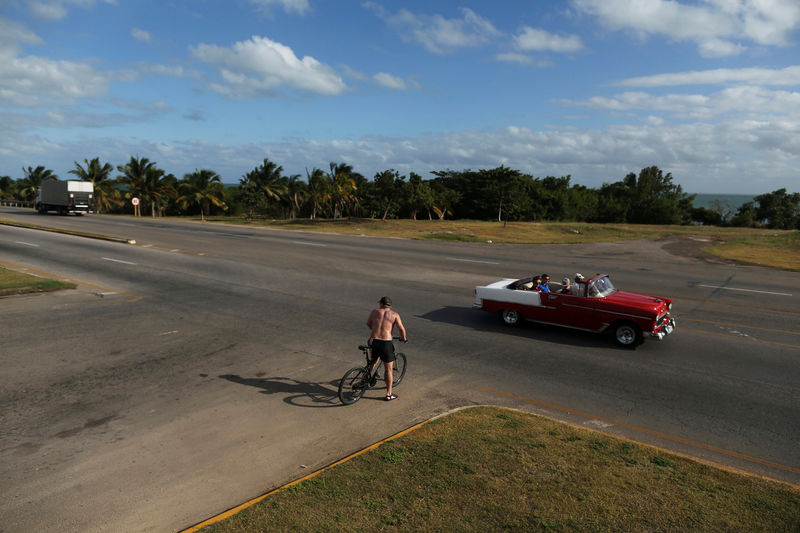 © Reuters. Tourists ride in a U.S. vintage car in Varadero
© Reuters. Tourists ride in a U.S. vintage car in VaraderoBy Marc Frank
HAVANA (Reuters) – U.S. travel to Cuba is bouncing back a year after Hurricane Irma and the Trump administration delivered a one-two punch to visits by Americans to the once-forbidden island, according to data from the Cuban Tourism Ministry.
The number of Americans traveling to Cuba through September totaled 460,646, according to ministry figures seen by Reuters, down 8.8 percent from the same period in 2017 but significantly better than the 24 percent decline year-on-year reported through June.
That mirrors signs that Cuba’s tourism sector in general is gradually recovering from a difficult year marked by hurricanes that devastated the Caribbean and U.S. President Donald Trump’s reimposition of sanctions after his predecessor Barack Obama restored diplomatic relations and visited the island with his family.
Tourism Minister Manuel Marrero last month said that total arrivals this year would top the previous year’s 4.7 million despite a slow start, while next year visits would reach 5.1 million.
A majority of American visitors through September came by cruise ship, travel that is led by the likes of Norwegian Cruise Line Holdings Ltd, Carnival (NYSE:) Corporation and Royal Caribbean Cruises Ltd, but agencies that bring groups of Americans said their business was also picking up.
Analysts say the cruises, which began in 2017, tend to cater to a sector with less income than group or individual travelers, whose trips can be quite expensive. Cruises also appeal to the less adventurous as the companies guarantee the legality and safety of their trip.
The number of Americans arriving by cruise ships through September was double that of 2017. Meanwhile, 222,000 flew in for longer stays on the island at hotels and private bed and breakfasts, a drop of 42 percent according to the ministry report.
Cruise passengers spend little on land, while those vacationing on the island spend much more at hotels, bed and breakfasts and restaurants.
That drop in tourism revenue is painful for Cuba’s private sector, which operates 2,000 restaurants and rents out 24,000 rooms, as well as for the Communist-run government, which owns most hotels and is struggling with declining export revenues and dwindling support from crisis-hit ally Venezuela.
GROUP TRAVEL RECOVERING
A Reuters survey of a dozen U.S. agencies that bring groups of Americans to Cuba for longer stays found unanimous agreement that bookings were recovering for this season beginning after Christmas.
Collin Laverty, president of Cuban Educational Travel, which brings hundreds of groups to Cuba every year, said business was up 25 percent over 2017.
“You can feel it in the streets if you walk around Old Havana,” Laverty said, with the colonial district of the city behind him and facing two huge cruise ships docked in Havana Bay.
“The cruise terminal is filled. I have never seen airfares so high. Obviously, demand is outstripping supply, so things are looking good.”
The U.S. trade embargo restricts Americans who visit the island to non-tourist activities such as cultural, religious and educational travel or family visits.
The Trump administration has made it more difficult for Americans to travel to Cuba on their own and banned them from patronizing military-owned hotels and other establishments.
Further complicating matters, the administration cut its Havana embassy to a skeletal staff in 2017 and issued a travel warning, which it only recently downgraded, after 26 of its diplomats were sickened by what it views as possible sonic attacks.
Travel providers said all the bad news was fading, with Cuban music, art and the prospect of adventure once more enticing clients.
“American memories are short,” said Steve Cox, executive director of Alabama-based International Expeditions. “Interest in going to Cuba has come back and we are looking forward to a much better year in 2019.”
The figures do not include Cuban-Americans, more than half a million of whom arrive every year to visit family and friends on U.S. carriers American Airlines, United Airlines, JetBlue, Delta Air Lines (NYSE:) and Southwest Airlines (NYSE:).
Source: Investing.com






























